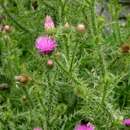en
names in breadcrumbs


Carduus is a genus of flowering plants in the family Asteraceae, and the tribe Cardueae, one of two genera considered to be true thistles, the other being Cirsium.[1] Plants of the genus are known commonly as plumeless thistles.[2][3] They are native to Eurasia and Africa, and several are known elsewhere as introduced species.[3] This genus is noted for its disproportionately high number of noxious weeds compared to other flowering plant genera.[4]
The genus name Carduus is from the Latin for "a kind of thistle"[5] or "thistlelike plant".[3] It is related to the word Cardonnacum ("a place of chardons or thistles"), which is the origin of Chardonnay, the name of the grape variety.[6] It is also related to the word card, which as a noun means a device (often a stiff-bristled brush) for aligning and cleaning fibers, and as a verb means the action of processing fibers in that way.
These are usually annual or biennial herbs, sometimes perennial. Species often grow 2 meters in height but are known to reach 4 meters. The erect stems are winged and spiny, and usually have woolly hairs. The leaf blades are hairy to hairless and entire or divided into lobes, and they have spine-toothed edges. The flower heads are solitary or borne in inflorescences of up to 20. The head is spherical to cylindrical and covered in several layers of spreading or curving spine-tipped phyllaries. It contains long, tubular disc florets in shades of white, pink, or purple. The fruit is a cypsela tipped with a pappus of barbed bristles or scales.[3]
Several Carduus are notorious invasive plants outside their native range, for example, in Australia[7] and the United States.[8] Species such as C. acanthoides, C. nutans, C. pycnocephalus, and C. tenuiflorus easily become weedy in disturbed habitat, such as overgrazed pasture. C. nutans is allelopathic, producing compounds that inhibit the growth and development of other plants.[8]
Agents of biological pest control that have been used against weedy Carduus thistles include the thistle head weevil (Rhinocyllus conicus), thistle crown weevil (Trichosirocalus horridus), and thistle crown fly (Cheilosia corydon). The musk thistle rust (Puccinia carduorum), a fungus, may also be used against C. nutans.[8]
There are about 90[3] to 127[9] species in the genus.
Species include:
Carduus is a genus of flowering plants in the family Asteraceae, and the tribe Cardueae, one of two genera considered to be true thistles, the other being Cirsium. Plants of the genus are known commonly as plumeless thistles. They are native to Eurasia and Africa, and several are known elsewhere as introduced species. This genus is noted for its disproportionately high number of noxious weeds compared to other flowering plant genera.